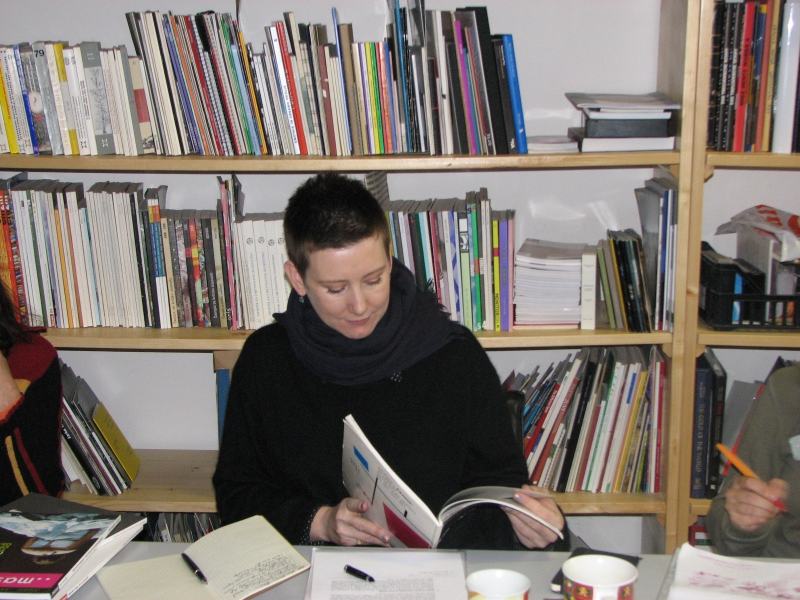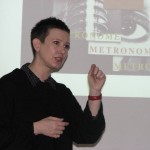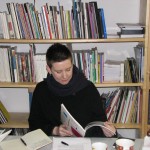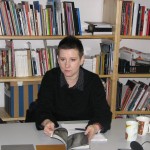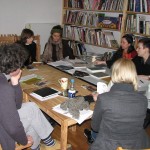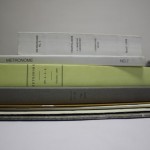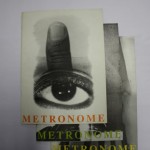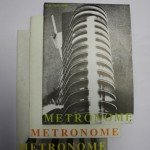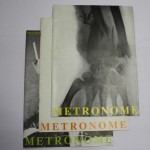Saša Nabergoj: conversation with Clémentine Deliss
I wanted to talk about the beginning. You did a PhD in social anthropology. Afterwards you began to work as a curator, and after doing some exhibitions you set up an independent organ Metronome, a place for curatorial research with artists and writers. Could you tell me more about what you brought from anthropology to curating in the field of visual art, and about the shift from the “classical” format of the exhibition to the publication as a curatorial project?
Well, I didn’t begin studying anthropology; I studied art in 1977−80 in Vienna. And I already had a background in design work, because I did a lot of shoe design for my father who had a shop in London. So I was used to workshops. When I studied art in Vienna I realised that it required a lot of information and that I needed to find out more. I wanted to know about the underpinnings and the background of the works that artists were producing in the late 70s. So everything from late actionism, performance, experimental film and then through to conceptual work and early installation art. And all these led me to study social anthropology. I don’t think I would have necessarily studied anthropology if it hadn’t come from art practice and if there hadn’t been the connections of conceptual artists to that discipline. Anthropology is similar to art history or other disciplines: it depends on the institute and who is teaching there. So I studied first in Vienna, which was very historical, then in London, where I finished my bachelor studies at The School of Oriental and African Studies and subsequently went on to do a PhD. Whereas the Austrian Institute began with 15th and 16th century anthropology and stopped at Durkheim, UK semantic anthropology went from Durkheim to post structuralism. I worked on an idea of interpretation, that which fuelled the desires of artists and fuelled the desires of anthropologists at a particular moment in time, the late 1920s in France. I discovered a magazine called Documents, which was produced in 1929−30 and edited by Georges Bataille – in 1986 few people knew about it – and I realised it was a key between the two areas of art practice and ethnology.
After completing the PhD, I quickly left the whole world of anthropology and went back to art. I felt that social anthropology was interesting in terms of the analysis of text and the reflexivity and semantic developments around the discipline itself – it was very self-critical, interested in the problems of methodology – but there was very little relevant information or approaches to visual culture and to the material object. So I went back into art. At the time I believed that a curator was someone who sets in motion a series of ideas together with artists within an exhibition space. I wanted to set up complex, unresolved ideas with artists. And the show I did in Graz and Vienna called Lotte or the Transformation of the Object was exactly like that. So it was an important exhibition that allowed me to research ideas using an exhibition space together with artists.
I initiated Metronome in 1996 after having worked in television production and done a lot of travelling. I became increasingly interested in the way the discourse of art in Europe was unable to retain its original borders between western Europe and north America. And I got interested in the global question. It was at that point that I began to travel more to Africa and realised that if exhibitions had at one point been research spaces that in the early 1990s they weren’t enabling that kind of experimental research to take place any more especially if I wanted to work with artists who came from contextual environments with different histories and different backgrounds. So I came back to the idea of the organ, the organ as a way of working with artists and writers that enabled me to short circuit some of the fears around contextual knowledge. I decided at that point that I could get artists professionally interested in other artists if I managed to bring together the blueprints or the earlier phases of knowledge production together rather than the final works.
In a way, Metronome is a document of a specific period of working with specific artists and writers in a specific location. Would you agree that Metronome is a document of the development of your relationship with different artists, writers, and scientists? Why do you feel it is necessary to have a printed “product”?
I always hope that Metronome won’t become a book again. The important thing about Metronome is that I can control it myself and that my only responsibility is towards the artists and writers I work with. No one tells me that I have to do Metronome in this way or that, or that I should include certain people, or that I should have an editorial board, or that I publish regularly, or that it should have the same format it had before.
So I am always looking for another medium, another channel, another vector or, if you like, another transducer, something that will articulate an area of production that’s taking place, and make it interesting or provide an angle for somebody else from somewhere else to want to know more about it. And so it really can take on any shape. And what is interesting is that my moving around has been the key to the different productions. However, each production whether it takes place in Scandinavia or Dakar or Tokyo, as recently, is not about reflecting on these locations. It just so happens that when I go there something happens in the relationships that I set up or that people set up with me that makes me want to develop an idea in that specific location. And then obviously I go to print. But if I am in a location where I don’t feel the necessity, as was recently the case in Melbourne, then I can’t do it. So Metronome is a document of my relationships with artists, and yes, if you look at the list of artists, it’s pretty extensive.
I think that what is fascinating about this kind of work is that as you go along, you realize the variable speeds of different information circuits. You could argue that since 1984 and the exhibition Primitivism in 20th century Art (MOMA) – and that’s now 23 years ago – we have been confronted with locations and modes of art production that we had never had to deal with before. If in 1984 we saw the death of the overarching model of formalist affinities in primitivism, in 1989 we were faced with Les Magiciens de la Terre and yet another perspective on gathering artists from different cultures. Following Les Magiciens de la Terre, you had a period of maybe five or six years when curators in the States and in France in particular tried to animate new interest, but on the basis of very naïve understandings not only of the developments of art in Africa but equally of new art tendencies emerging in Europe and the USA. Then since 1995 I guess you have an increasing acceleration of information coming through, but equally of the younger generation. After 23 years there is now a powerful new set of artists and practitioners that deal with the relationships between contact and documentation in different parts of world. In this context, Metronome is sometimes closer to a collective art work with a very idiosyncratic research methodology, and less and less like a catalogue or accessible form documentation.
You wrote in connection with Metronome about metalogue, about the relationship between the content of research and the structuring of it. Can you explain this a little?
I had heard about Gregory Bateson before because he was married to the anthropologist Margaret Mead. Gregory Bateson is a curious maverick figure rather like a polymath. Bateson’s idea of the metalogue is based on the value of recursiveness, of knowledge looping back onto itself and in so doing enhancing the subject.
I guess the most interesting editions of Metronome are the ones that can actually do that. And one of the most interesting things for me when I travel is to locate a local organ from whatever period in time that allows me to develop a format through which to introduce a new debate that is local to the place where I have arrived. For example the new issue of Metronome, which is being produced in Japan and is based around art and education, is not taking up at what I thought it would. My original interest was in Japanese propaganda magazines from the 1940s. One particular propaganda magazine was called Front and it was produced in 16 languages including Burmese, Tibetan, Chinese, German, English, and was nearly entirely visual. It was produced right after the bombing of Pearl Harbour in print runs of nearly 80,000 copies. Front was both formally and conceptually interesting as a magazine that went beyond language. Yet the actual model for the new Metronome is not going to be as nostalgic as that. It is going to be from 2004! It’s a yellow book that is an artwork produced by the Japanese artist Masato Nakamura and it’s called Sleeping Beauty. So with his permission I am basically producing a new version of his book. It will look the same as his book and that way will draw attention to what he has done and act as a metalogical translation of what we were doing in Tokyo in September through the Metronome think tank on art and education.
I see a turn here towards a slightly different direction than the one from the beginning when the first three issues of Metronome adapted the format of the Senegalese tabloid press. The others, like for example number 10 (based on a zine from Oregon), adapt formats of publications as a kind of compliment or acknowledgement.
The first three were test beds. With number 0, I had no idea how this would work. Through my work on the magazine Documents from the 1920s, I learnt to appreciate the division between text and image. So when I began Metronome, I didn’t want any excessive graphics such as those we saw so much of in the 90s. At that time, there was no page that didn’t have a bubble of an image, several different fonts, shades, and colours blending over one another. I wanted to create a kind of polyvalent journal, so that you could look at it entirely through the visual half, get something out of it, and articulate ideas, just as you could also look independently at the written material which in the case of the first three editions (Dakar, London and Berlin) was always translated between two languages. I like the idea that as a reader you make a decision about which part you want to read and that you will float between the meanings that are conveyed by different languages.
The Bastard, number 7, is all about that. The Bastard has no images whatsoever, because it was about the voice, the use of a voice. What is interesting is that it contains more languages that I can speak and therefore wherever it goes the front door, so to speak, the entry into the book, changes position. So if you are in Senegal you will open it up and you will begin to read the Wolof text, and then you will find neighbours that you may be interested in, but if you are in Iceland, you will start with the Icelandic text, and in France you would probably begin with French text. It was a way of saying well, people assume they are reading the entirety of a book, because it is in English or in Slovene, or in German, but that’s very rare in art that you read the whole book, or that you retain a memory of the whole book. You will only take a segment back with you.
At the end of 90s you began to work and produce Metronome within the framework of art colleges. How did this environment change your practice? Even if you did maintain your independent position, did the shift affect the selection of people you worked with? Did you begin to work more with students?
What you have to remember is that with the first four issues, produced before I began working in art academies, my approach was to combine artists as yet unknown with known artists. Which isn’t something terribly new, but the idea was that reader would look at Metronome and would say ah, Paul Virilio, ah, there’s Rebecca Horn, there’s Slavoj Žižek, and then next to them would be somebody that they didn’t know at all. This person would be probably important in the city or the country they were based in yet not connected to the same information circuit, and also some of them were simply still very young.
So I was already working with different generations of artists. When Kasper König asked me to work at the Städelschule as Guest Professor for the first time, I was offered luckily a very exceptional situation. I have never been asked to teach and I think that if I hadn’t experienced this initial environment, where Kasper said, you are a guest professor, you do what you want with the students, make a film, make a book, I don’t mind, I probably would never have held it out.
And at the same time, in 1999, they wanted me to do something in Vienna. And then in Edinburgh, and in Bordeaux. So I went to all of them and I said ok, I want to find out what the knowledge base is going to be in an art college. But I want to do it through the students. In 1998 crossover was the thing. So you could cross into any other discipline, any other culture, any other format and you could take what you wanted and create a new kind of relationship between art and fashion, art and design, art and architecture, art and theatre, you know, whatever. I wanted to tighten the screws on the loose attitude that students had towards referentiality.
So I said to students of the Stadelschule, I do not want to produce a catalogue of your works, as nobody is interested in young students’ art works. But I want you to clear up your back store. I’d like to know what you read. I’d like to know what work you do outside of the art academy. I’d like to know if you have a guru, for you to invite them to be a part of Metronome. That’s basically what happened in all those four locations. It happened within 6 months and I raised the money from all the colleges. It was very fast. But it was only because König and the other rectors in Vienna, Bordeaux and Edinburgh had given me that freedom of movement.
Afterward when I decided to work on the use of the voice, because I was dissatisfied with conferences in contemporary art and I had noticed that I have the ability to make myself understood in public. I wanted to understand what wasn’t going right in the way people were speaking at conferences. And what happens when artists use the voice and through this, to quote Mladen Dolar when he says, “the voice may well be the key to the presence of the present”. In another words how do we deal with presence through the use of the voice? But that was much more difficult. I have worked in art academies as a curator and publisher for many years now, but it’s not always been easy.
First you were producing Metronome, but then you became interested in a crisis situation that many art schools found themselves in at the beginning of the new century. They were rethinking their position, trying to figure out what do to next, what kind of structure they would need, and what kind of knowledge?
I worked in art colleges because they gave me the freedom to do research and as a curator to find ways of producing work with people. Art colleges were going through this new shift and I became interested in that. Whereas museums were becoming more and more the same, with similar collections, and similar ways of working, art colleges were going through a transformation and were very diverse.
I felt happy in the art schools, certain art schools. Because it seemed to me that they had been the place that had originated my curiosity in research in the first place. I like the environment of the art school. I like the way people move in an arts school. I like the use of fashion and coding amongst students in an arts school. I like how they work in studios. I think I was particularly excited by the small German art college, like the Städelschule when it was being run by König because of its slightly loose way of working. It wasn’t trying to be too trendy or too fashionable. An art school remains a place for me where very interesting conceptual work can be done, together with forms, and with interpersonal relationships. University has that rather problematic dimension, which is that offices are usually ugly, and academics however brilliant they are sometimes lack atmospheric or perfomative qualities. The university environment is a bit dry for me sometimes.
You initiated a research project called Future Academy. You developed the idea through which you connected several art colleges throughout Europe. Could you tell a bit more on the history and structure of the Future Academy?
Again it comes down to people. I was back in London and once again was offered this opportunity as a curator to work in an art school without doing formal teaching. One day, the out-going Head of Chelsea College of Art, Colin Cina said to me: “We’ve just bought this big site on Millbank, next to Tate Britain. It’s a former Royal Army Medical Army College. It won’t be refurbished for at least two years, why don’t you do something in it with postgraduate students. Whatever you want.”
And so that’s what I did for a year. And it was the craziest environmental situation that I ever worked in. Because the site was huge and we had to have walkie talkies to find our way around it and there were unpleasant laboratories, soldiers had lived in there, medical doctors and students and it had a history of being a target of the IRA. There were mad rumours and stories about that. I put together a group of 9 post-graduate students who had just finished their studies and we met and worked there regularly for a year, inviting artists on tours through the site.
And we ended up doing a new issue of Metronome, number 8A and 8B. Afterwards I said to the Colin Cina why don’t we do a conference about changes in art colleges? And that grew from being just an idea into something bigger. We thought, why don’t we get some other institutions who are interested in this crisis to look at it together and that was how we managed to fund it, by pooling extra resources. It was clear that they couldn’t give me a position. So Colin Cina used his power and his reputation to get Glasgow School of Art, Edinburgh College of Art and the London Institute (now University of the Arts) to find some extra money that would help me pay my rent, and keep me going to develop this idea. And we also went to the Arts Council, we went to the European Union, and we talked to people at very high level about this changing situation. We tried to encourage art colleges in Europe to come on board and become part of the research collective. But the art colleges in Europe wanted the investigation to focus only on changes in the Bologna agreement or things that would be of benefit to themselves, to an elite European art group. And it was at that point that I thought to myself that this has to be done in connection to the ex-colonies because we had exported art schools to India and to Africa and I wondered whether there was a concordance in the crisis of art schools in these continents too. I though it would be more interesting to do it on a more global level. So that’s how I spent one year working in Senegal and in India. And then after that the money ran out in London and Edinburgh luckily decided to keep me to do this. I have now worked for nearly three years with Edinburgh to develop the Future Academy.
You worked with professionals and students using the format of the think tank (in Dakar, Mumbai and Bangalore) and now something similar with Studiolab (Edinburgh). In all three places research was focused on three main subjects: epistemological, architectural and structural questions on the future of the art academy. Can you tell me more about the process?
Each time it is a case of assessing the interest and motivation on the part of my potential colleagues or co-researchers wherever I am. I’ve worked like this with Metronome when I arrive in a new location. So with Future Academy, I go into an art school and sympathetic professors rustle together their students, and then I pitch the project to them and see their response. I did this in India, in Scotland and in Dakar, which was an incredible moment when I spoke to 150 Senegalese art students. I was the only white person there. And it was the most surreal situation. And I said to them ok guys, this is a situation, you are in an institution, there is a very fine line between the freedom you articulate and manipulate within this institution and the kind of freedom that you may want to set up for yourselves once you leave art college. So I am asking you to look at this institution as if it were nearly your professional context.
The key has been to think about this in terms of the future, rather than the present. This is crucial for Future Academy, because if there is a crisis in the art educational system then this crisis cannot be resolved directly by Future Academy. So we have created a scenario or conceit whereby we think 50 years ahead. And 50 years seems to be the right amount of time because my generation will be gone, but equally paradigmatically it refers to shifts in the 19th Century, then later the Bauhaus and now a new kind of change in art and education. It also means that the students will be closer to seeing their ideas implemented than us. So Future Academy has been always student-led. But students have had to want to get involved. And so I pitch to them on three levels; who you want to work with, what is the map or cartography of your professional world, what is the way of working that you think is the best for the future, and what is the knowledge that you are already involved in producing? How do you integrate the jobs that you do outside of the college into your work as an artist? Many art students are involved in social work. So what do you do with this information, and what do you think about access to the art college? Even the word “academy” can throw up incredible debates about exclusion, exclusivity, how one gets somebody who is not educated into the academy, and what to do about cultural diversity. And the presence of aesthetic practices, that are not recognized in the academy but are part of life and culture, even oral culture, all those sorts of things.
Another area that we worked on was architecture. We asked: do you need a building for a Future Academy? No, we don’t need a building, most of them said. We need energy points and we need people and we need face-to-face meetings, but we do not need a building.
The structural issue is something that I haven’t resolved yet except through my own activity, which is reflected in the way that I have produced Metronome. At the heart of Future Academy is something that I have always wanted, which is to set up a roaming faculty. Because I think it is the only way that you can get a deeper transfer of knowledge. I don’t believe in one-week seminars, I don’t believe in this kind of system. I think you have to bring people over for longer periods of time to work and engage with their own research in another context and with different people. And this will help the circulation of ideas. I tried to set up this roaming professorship through Future Academy but actually I ended up doing it myself informally. So I haven’t quite managed to achieve that yet.
The roaming professorship is connected to the question of knowledge transfer. What knowledge for which context? What art history? African? American? European? What knowledge is relevant for let’s say the three locations that you worked with? What are the faculties of knowledge for the Future Academy?
It’s really about introducing and educating students to work with a rigorous understanding of methodology. Once that is done, you can bring in practically any material. These rigorous methodological procedures are related to their work, how they research as an artist not as an academic, and how they understand the ways and approaches of other artists’ research.
It is difficult to make a big statement on whether you have to have the art history of former Yugoslavia to have a local relevance, because the local is now as they say translocal. But there are subject matters, which I think would make a difference to an art academy and that people kind of take for granted. I think it would be good to have professional people to work with artists.
You have a faculty of knowledge and within this faculty you can have a lawyer, but not necessarily someone specialised just in copyright. A lawyer who learns with you, researches with you, maybe starts to work with you, and develops those areas of legal systems that need to be looked at so that artists have more autonomy. And it could be immigration, it could be identity, it could be security, it could be health, it could be a whole number of questions that artists can regard as an aesthetic project along with a lawyer who would look at these questions from a judicial point of view. I think it would be good to work with an economist. And with an ecologist, a person who looks at the interrelationships of ideas and things, and of environments and conditions. These people could be quite stimulating in an art college context.
So we are talking about the polymath team of the Future Academy, people who have different skills and knowledges, competences to work together. There is the question of when a polymath becomes a dilettante. Can you set up a structure to prevent this? Is it even important?
I don’t know. My team in Edinburgh has done a lot on the polymath. And I think it is interesting to think about the polymath because certain artists work that way. More and more people want to work together from different fields and have to deal with absences of knowledge from other fields. It can be frustrating to work in an interdisciplinary way if you are also dealing with these blind spots on an intercultural level and very big holes in information. So the dilettante is an inevitable outcome of this kind of pluridisciplinary context. And unfortunately I think that the fine art context breeds more dilettante interpretations then any other context. You know I wouldn’t dream of presuming something about computer science, but computer scientists will make assumptions about art that is often frankly a sign of dilettantism.
Let’s go back to the structure of Future Academy, more precisely to the think tanks you set up, and Dakar for example. They also involved people that you worked with before, not only students, but also active professionals from very different fields.
Well Dakar was the very first think tank for Future Academy and it was very special. I brought together intellectuals, artists, musicians, lawyers, information scientists, all people who in Dakar don’t often meet and debate. It took place at the house of an architect. And there were a few arts students there too. But actually there were more people in their 30s and 40s or even older. So it really was a kind of top-level intelligentsia. And afterwards it became more student-led project. I went back to Dakar three months later and set up a cell of 20 people who came from a new media lab and from the national art college in Dakar. And that was very powerful. They were very good.
Did they continue to work when you left? Or was it more a situation that you generated a kind of dynamics that eventually died out?
It petered out in a formal sense. But you see, it doesn’t really matter. The business of continuity is complex. One wants something to continue but one forgets that students pass through. Students aren’t responsible for maintaining a project. They learn from it and then they move on to something else. It would be wrong for me to assume they have to keep it running. Because one of the key aspects to Future Academy has been to remind everybody all the time that we are not it, we are not the Future Academy. We are not an institution. So we are active in doing fieldwork and investigating ideas, bringing people together whilst all the time saying that this is in order to understand what the future may bring or be. But we are not the Future Academy. And that constant playing with blind spots or coming back to reality is really curious and bizarre. Sometimes you realize that you are doing it. You are the Future Academy. And other times you draw back and say no, no, this is a conditional exercise.
You have a constant team, at least in Edinburgh. But in Dakar and India, you just got together a group for the one event at a time.
No. In Dakar there was a cell, a group too. I had to find every way possible to keep it going and to be able to go back often enough. Then I went to India and started working there as well. In Bombay and in Bangalore. I never select students. They elect to be involved. In Edinburgh the same thing happened too following on from the African and Indian experiences. It was the cartography of Future Academy.
In Edinburgh we worked on the notion of a building. Because Edinburgh College of Art had just decided to buy a building and in India, the students had said, “we don’t want buildings!” So it made it really crucial to have a symposium to discuss what to do about buildings, to be with or without walls. To ask, why it is that governments support the construction of new art colleges? Most people don’t know what a studio is anymore, and health and safety issues prevent people from socializing in a lot of art colleges, so the computer room becomes a social hub. All this is changing every minute. And so the team that I set up in Edinburgh again based on elective students from different departments, photography, television, and architecture investigated these questions. The final phase more recently has been in collaboration with the School of Informatics and the Department of Digital Design at the University of Edinburgh. First there were structural investigations, then there was the architectonic, and now we are looking at the question of the knowledge base or the epistemological in collaboration with an area in the University of Edinburgh that is fundamentally interdisciplinary.
As the years go by with Future Academy the question of the elective voluntary group at a postgraduate level has become actually very subversive. Because you are able to do what you want, yet you are also confronted with a problem of motivation rooted in the lack of financial responsibility on the part of the students. They don’t pay for your course so they don’t have time!
You said that you are not the one forming the Future Academy; you are just investigating possible ways. So what would the result of this investigation be for you? When do you think your investigation will have come to an end?
Well, frankly I think Future Academy has run its course. I don’t really want to continue next year. I have done it for five years and I have listened to a lot of different people and covered everything I wanted to cover with it. When I started Future Academy, the question of the transformation in the art college was being sensed but hadn’t yet been developed by the people inside the art colleges such as you might find it has today. So 5 years on and art colleges have tightened their belts and worked on their future. Not everywhere. It is still a big question. One can do a lot more research on the global issue, on the question of the empire, globalisation and the arts school. But that’s not really what interests me. I would like to put into practice some of the areas we uncovered or developed.
And the academies? The ones that supported the project. How do they feel about it?
They know that the results of Future Academy operate on many levels. Number one, indirectly, it provides a pretty tough education in the methodologies of art and research.
They know I produce Metronome in the art world context, and they are more interested in that side of my work. And then you could argue in a way that it’s their problem not mine.
If I do something that’s heretical inside of the college you have to have good people to allow you to create this heresy. In certain art colleges it didn’t work, because the people who were running the college didn’t want another person coming in and messing around with a vision of a college that was constructed together with students. The heresy is too close to the bone. They don’t like it. But if you are with people who know you can only do good, in irrigation, in developing laboratories within the college, think tanks within the political context that are useful, they will support you but they may not know how to exploit you. Because if they exploit you, they have to formalize your position. And that’s actually what hasn’t happened until now. So I want to do something out of Future Academy. I want to direct. I have learnt enough, I am experienced enough and now I want to direct something.
Even if you don’t have a plan for the Future Academy, you have certain sets of ideas that for example came in very handy for us when you formulated some of these into blocks of questions for the workshop. But there is also the influence you had on the students with whom you worked and the impact that remains when they leave art college. In a way it is about spreading around ideas of rethinking existing models or even methodologies and how to approach anything in art, not only the question of art education. So what are your plans for the future?
I want to do something with the results and experience of Future Academy, but I also need to find the place of production that suits my work at the moment. I would like to direct an institution. And I want to work in a different way than before, in a different area of production. I would be very interested in helping to set up new research station.
When I was younger I was very nervous. I could never imagine that I would run a private gallery. I was always fascinated by how a person who runs a private gallery has the audacity and ability and courage to say, “I will sell this artist”, especially if it was an unknown artist. I am not saying I want to run a private gallery, but I think you see more in private galleries then in museums. You see new work. I am interested in new work and I am interested in an earlier phase of work, the work before it’s completed, so I have to find a location where I can support the production of interesting dialogues with artists prior to the finished production of work. That’s what I am mainly interested. In the early phase of development, not in finished results.
For a forthcoming publication by BAK Utrecht, Concerning Knowledge Production, you write: “For art institutions, the inclination towards theory and intellectual discourse need not be transformed in any extreme sense, for we should always support spaces that encourage reflection and discussion between people. Instead it may be helpful in these institutions to encourage a sharing of those scenarios and activities that tempt representations of that which is not yet known, and – as the metalogue – so neatly proposes, build new forms of knowledge production around them.” You were referring to the forms of knowledge production and content?
Yes, because discussion in art practice is now part of a big machine, and more and more art galleries now set up seminars, discussions, workshops, think tanks and laboratories. There are so many now. What do we do about it? Is it a bad thing? And my answer is, no, it is not a bad thing. However if you do set up a discussion you can also think about the format and make it a bit more fragile. But to do that requires quite a lot of work. I have to say that if you invite people to a think tank, you can’t just expect them to turn up and be ready to provide the kind of conceptual intimacy one needs for a real discussion to take place and to be open and fragile about ideas that they haven’t been properly worked out. To be very very open, very very tentative about ideas that may be completely foolish is risky, yet vital. You can’t do that unless you cultivate a kind of an invitation. The invitation becomes so important. If the discourse industry is something that we want to encourage, because it’s good when people talk, one also has to encourage experimental way of doing it within the context of art venues, and allow people to work more with the poetics of theory, to work more with translation, with foreign languages, and to change registers more often. Just changing the way of listening to speaking as well. Those things are nearly the work of a hostess. You’ve got to be aware that a debate won’t happen if you throw people in a room.
First published: “Curator is the One who Generates Ideas in Collaboration with Artists”, Saša Nabergoj: conversation with Clémentine Deliss, Artwords, No. 79, 80 (Summer 2007), pp. 164–172.
